PinotFile: 6.26 May 13, 2007
|
Pinot Noir in Strangest Places
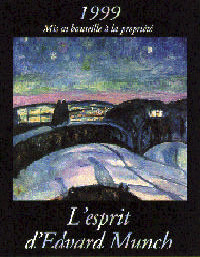
The most northerly vineyard in the world lies in Norway at latitude 60 degrees North. The Hallingstad Vineyard consists of 5 planted acres of primarily Pinot Noir, with smaller amounts of Riesling, Chardonnay, Viognier and some other hybrids. The site is appropriate for grape growing because of the neighboring Oslofjord whose waters keep the temperature mild in this unique microclimate. The first 2,000 vines were planted by Sveier Hansen in 1992 and the first Pinot Noir released in 1995.
The Pinot Noir is named after the painter Edvard Munch who lived in nearby Asgardstrand in 1897. Each vintage of L’Esprit d’Edvard Munch has a label showing one of Edvard Munch’s paintings as a tribute to both the artist and the wine. The numbered bottles in the Munch series (1995-1999) are snapped up by collectors and a full series is worth considerable money. According to www.wineweb.com, Harald Nordi, writing in the Swedish publication All About Wine, the Pinot Noir is “lighter than a Burgundy, but darker than a Beaujolais. A surprisingly intense and complex bouquet, dominated by wild raspberries." On of the largest producers of wine in Romania, Halewood Romania LTD, began distribution of their wines in the United States this year. Halewood Romania was established in 1997 by Halewood International LTD, the largest independent wine and alcoholic beverage supplier in the United Kingdom. Three brands are being exported with the selection representing a mix of international and Romanian varietals. The Byzantium brand labels feature ancient mosaics and other artwork of the Byzantine period, and will feature a Pinot Noir Rosé. The Prahova Valley label features reserve wines aged in French and Romanian oak barrels for 6-12 months and will include the Prahova Valley Reserve Pinot Noir ($12). The Cherry Tree Hill label offers single-vineyard or special lots produced in best vintages. Halewood Romania is currently undergoing a modern renaissance in winemaking with state-of-the-art technology and an international production team including winemaker Stephen Bennett with over 25 years of experience in Australia and Romania and viticulturist Valentin Resteman from Australia. The country’s historical vineyards have been replanted with the latest rootstocks and clones and modern trellising systems are being utilized. Halewood Romania manages 968 acres of vineyards and operates five production facilities in Dealu Mare. Winemaking in Romania dates back 3,000 years when the Greeks established vineyards near the Black Sea, and continued with the planting of Germanic varieties in Transylvania by the medieval Saxons. French varieties were introduced following the phylloxera epidemic in the 1880s. As a result, these varieties have been in Romania twice as long as other eastern European countries. Several indigenous varieties remain today. There are minor plantings of Pinot Noir in China and China does make its own wine. However, labels like Great Wall and Dynasty do not nearly approach the quality of, say, fine California or French wine. Today, fine wines from the United States and Europe have become symbols of luxury to the Chinese. The Chinese are particularly fond of the Bordeaux first growths from the five great chateaux, but it won’t be long before they start showing an interest in fine Burgundy as well. Imported wine remains extravagantly expensive to most Chinese, but it is only a matter of time when it will join the other modern lifestyle changes going on in that country. There are some old traditions that need to be discarded, such as mixing fine wines and adding Coke or green tea, habits that resulted from the country’s past history of producing poor quality wines. I could not discover any data indicating that Pinot Noir is planted in India (probably too warm), but the Indian middle class is developing a thirst for fine wine, including Pinot Noir. The market is growing at 30% per annum. A National Wine Board has been established to promote the health angle of wine and the wine industry in the country. India now consumes 3.5 million bottles a year (still a miniscule amount compared to the United States). According to an interview of the Louis Jadot Chairman by Sommelier India (localwineevents.com), Jadot started exporting to India in 2003. Burgundy now constitutes 15% to 18% of the Indian wine market by volume (30% of the market in terms of value). Pinot Noir might not be the first wine you think of to pair with Indian cuisine but it does fine with tandoori dishes. The lower tannins in Pinot Noir can be a plus for spicy dishes, and a little chilling may be beneficial, but high alcohol Pinot Noirs should be avoided. Because Pinot Noir and curry are not compatible, Merlot is a better choice especially with sweet curries. (see next article for wine and food pairing matches).
Matching Food and Wine is RewardingMaster Sommelier Rene Chazottes Well-known Canadian-based wine writer and sommelier, Natalie MacLean, now offers a new web site devoted to food and wine pairings. The author of Red, White and Drunk All Over: A Wine-Soaked Journey from Grape to Glass, Natalie has tried to simplify and clarify the challenge of matching modern fusion cuisine and wines from new regions around the world. In addition, appropriate wine matches are suggested for common, everyday foods like TV dinners, fried chicken take-out, and even dessert such as Jell-O and fudge. Her new website, www.nataliemaclean.com/matcher is a free, interactive matching tool. Visitors to the site can search by wine for meal inspirations or by food to find great wine choices. There are more than 360,000 food and wine combinations in the matcher as well as thousands of recipes for many dishes. Natalie is constantly adding more wines and foods based on the suggestions she receives from the 71,000 subscribers to her free e-newsletter,Nat Decants. If you have a dish or wine that stumps you, e-mail Natalie via the web site and she will suggest a match for you.
“The flavor of a food almost always reveals the quality of a wine and exalts it. In turn, the quality of a wine complements the pleasure of a food and spiritualizes it.” Luigi “Gino” Veronelli, wine critic (1926-2004)
What to Drink with What you Eat: The Definitive Guide to Pairing Food with Wine, Beer, Sprits, Coffee, Tea— Even Water— Based on Expert Advice from America’s Best Sommeliers, Andrew Dorenburg and Karen Page, Bulfinch Press, New York, 2006 356 pp, hardbound, $35. This is a new, comprehensive volume on food and wine matching written by a young married couple who have achieved well-deserved notoriety for their previous books (Becoming a Chef, Dining Out, The New American Chef, and Culinary Artistry). They elicited the opinions of seventy of this country’s most knowledgeable pairing experts, including sommeliers (Belinda Chang, Rajat Parr) and chefs (Daniel Boulud, Traci Des Jardins). This is a reference for the sommelier-wannabe student of food and beverage pairing. Sprinkled with many quotes to support explanations, the book is a treasure-trove of pairing information written in an up-beat and entertaining style. The heart of the book can also be used as a quick reference using the two encyclopedic chapters that detail matching beverages to foods and matching foods to beverages.
“The primary purpose of wine is to make food taste better” Myra Waldo
My bible of wine and food pairing is prominently displayed in my kitchen and I refer to this one book more than any other in my culinary library: The Vintner’s Table Cookbook: Recipes from a Winery Chef, Mary Evely, FRP Books, Nashville, Tennessee, 1998 (newest edition 2006), 176 pp, hardbound, $25. The introductory chapters deal with guidelines for food and wine pairing and includes a taste and an aroma wheel. The writing is brief, organized, and easy to comprehend. The recipes which follow are divided into chapters according to varietal. The most valuable pages in the book are tables outlining food affinities and food conflicts for each varietal. These profile tables are invaluable!!!!! Mary Evely was formerly the winery chef at Simi. Several years ago our wine club attended a wine and food pairing luncheon at Simi, and to this day, we still rhapsodize about Mary’s insights, her cooking skills, her book and that event. You must have this book!
Pinot (and more) By The NumbersPinot Noir accounts for 2.8% of the food store wine market but is rising rapidly. The varietal has grown by 26% in volume over the last year and 111% since 2005. Dollar sales have risen 24% between 2006 and 2007 and 117% since 2005. (Wine Business Monthly)The average restaurant price for Pinot Noir has risen from $45 in 1994 to nearly $70 in 2006. (Wine & Spirits) The 2006 California grape harvest was down 17% from 2005. Merlot fell even further, by 22%. Meanwhile, Pinot Noir and Pinot Gris both saw gains (12% and 16%, respectively). Pinot Noir’s gain is not nearly enough to meet current demand. (Wine & Spirits) Sales of Oregon Pinot Noir, by case, increased from 352,789 in 2000 to 810,950 in 2006. The 2006 Oregon harvest resulted in 20% to 30% higher yield than either of the prior two years. Supermarkets across the country are selling 20% more Oregon wine. (The Oregonian) Retail sales of Pinot Noir were up 20.3% in dollars in 2006. Rosé priced above $6.50 grew a startling 23.9% and rosé sparkling wine went up an amazing 42.9%. (Wines and Vines) A jeroboam of 1988 Domaine Romanee Conti Romanee Conti sold at Christie’s New York Auction (9/16/06) for $94,000 ($40,000 above estimate) Francois Pingult purchased René Engel’s 15-acre vineyard in Vosne-Romanee for 23.5 million dollars, the highest per acre price ever paid for vines in Vosne-Romanee. Exports of Pinot Noir from New Zealand increased 151% from 1/04 to 1/06. Pinot Noir has overtaken Chardonnay as the second biggest wine export for New Zealand. Big increases in exportation were noted to Canada, Germany, Ireland and Japan. 2004 world acreage of Pinot Noir: Champagne— 31,283 acres, Burgundy— 26,016 acres, California— 24,055 acres, Oregon— 7,637 acres, and New Zealand— 3,239 acres. 2004 total grape acreage: California— 440,296 acres, Champagne— 81,196 acres, Burgundy— 66,287 acres, New Zealand— 17,809 acres, and Oregon— 13,700 acres. Burgundy produces 105 million bottles of Chardonnay and 75 million bottles of Pinot Noir annually. There are 4,000 domaines, 59 types of soil, and the Cote d ‘Or stretches a total of 31 miles. There are now wineries in all 50 states. As of November, 2006, the number of wineries in the United States had increased to 5,970 (4,383 bonded and 1,587 virtual or non-bonded wineries). The top four states are California (2,923 wineries), Washington (507 wineries), Oregon (364 wineries) and New York (270 wineries). California added 465 wineries (28% increase) in 2006, Washington 65, and Oregon 49. Half of all North American wineries have an annual production of 15,000 cases or less. (Wines & Vines, Wine Business Monthly). 75% of U.S. wine drinkers purchase wines in the $6-$10 and $10-$15 ranges. Two-thirds drink that wine within a week, and almost one-third drink it within 48 hours. Nearly 74% of California wine is sold in the other 49 states!! 3-5 lbs-the weight of a bottle of wine. $30,925-the cost of a full page ad in the Wine Spectator. 40-the number of wine blogs on the internet in 2004, 400-the number of wine blogs in early 2007. 250-the number of Masters of Wine in 20 countries (24 are Americans). 6th-the ranking of grapes as an agricultural crop in the United States.
Small Sips of PinotMalm CellarsMalm Cellars is a one-man winery. Like many small Sonoma gargistes, Brendon Malm helps farm the grapes he sources from several vineyards, makes the wine, designs the labels, and delivers the wine to his customers in his diesel pick-up truck.
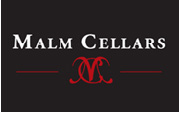 2005 Malm Cellars Sonoma County Pinot Noir 14.4% alc., $19. Surprisingly, the bottle sports a high-class wax cap, unusual for a valuepriced wine. · The aromatics are shy with hints of cassis and toast, but build in intensity with air time. A bit of heat peaks out as the wine warms in the glass. Easy to drink , this wine is soft in texture with red cherry and berry fruit. I wanted more structure and fruit, but I could not complain at this price. A simple Pinot that is perfectly fine for washing down a grilled hamburger.
Malm Cellars wines are sold primarily to retail and restaurant accounts. The address is PO Box 1524, Healdsburg, CA 95448. The phone is 707-363-0441, The website, www.malmcellars.com, has only contact information. Brandon Malm also crafts a 2005 Malm Sonoma Coast Pinot Noir ($38) which is a step up in quality. I did not sample it, but heard from a few sources who recommended it. Lucas & Lewellen Vineyards Winegrower Louis Lucas is originally from California’s Central Valley. His father was a leading table grape grower in California for many years. He has over 35 years of viticulture experience. Royce Lewellen spent his career as a Superior Court Judge. He teamed with Louis in 1996 to found Lucas & Lewellen Vineyards in Santa Barbara County. Their vineyard holdings are extensive and are located in the Santa Maria Valley, Los Alamos Valley, and the Santa Ynez Valley. Their winemaker is Daniel Gehrs who has worked over 30 vintages in California starting with the old Paul Masson Vineyards in Saratoga. He has his own label, Daniel Gehrs Wines, as well, which specializes in Rhone and Loire varietals. I first became aware of Lucas & Levellen Vineyards after tasting their Pinot Noirs that scored well at the last two annual Pinot Noir Shootouts.
 2005 Lucas & Lewellen Santa Barbara County Pinot Noir 14.0% alc., 3351 cases, $20. The grapes for this wine come from the estate Goodchild and Los Alamos Vineyards. Aged in neutral French oak for 8 months, it is intended to be consumed young. · A light-bodied Pinot Noir featuring cherries and sandalwood on the nose and spiced cherries on the palate. A decent quaff.
2004 Lucas & Lewellen Hilltop Santa Barbara County Pinot Noir 14.1% alc., 603 cases, $30. This is a limited bottling from the highest block of the Goodchild Vineyard, planted with Dijon clone 667. Barrel aged for 16 months in 40% new French oak barrels. · This wine is a step-up with more intense aromatics drifting towards super ripe dark cherries and prune. More body and more fruit than the above wine, it is black cherry-driven in the mouth with toasty oak overtones. Just fine with rotisserie chicken.
 B. Kosuge Wines Brian Kosuge was the head winemaker at Saintsbury for 15 years before starting his namesake label. He also makes wine for Miura in California and Kingston Family Vineyards in Chile. He currently has three releases: The Shop Carneros Pinot Noir, Hirsch Vineyard Sonoma Coast Pinot Noir $50, and a Hudson Vineyard Carneros Syrah $40.
 2004 B. Kosuge Wines The Shop Carneros Pinot Noir 14.5% alc., 325 cases, $30. The name “The Shop”, is in reference to Walsh Vineyard Management whose owners Brian worked with for many years. It also symbolizes his love for spending time in the vineyard and hanging out with vineyard workers. The grapes come from a small vineyard adjacent to the vineyard equipment shop. · This is a nice package which is deftly crafted and very easy to drink. The nose is tinged with black cherry, vanilla, and oak, and the flavor profile features darker fruits including plum and black cherry. Tannins are nicely integrated and the wine is beautifully balanced. Overall, a little more sappy and darker than the 2004 vintage of this wine which I also liked very much.
B. Kosuge Wines may be purchased on the website at www.bkosugewines.com. The winery address is PO Box 5413, Napa, CA 94581, The phone is 707-738-8396. Portalupi Wine Company This is one of those wines that comes out of nowhere and renews your faith in the Pinot God. Paul Root at Root’s Cellar in Healdsburg turned me on to this Pinot Noir from a “famous” vineyard in the Russian River Valley (hint: it rhymes with cannoli). The wine was blown out of his shop in a few days and when I asked him about it, all I got was a sh..-eating grin. The label only says Portalupi Wine Co., Sonoma and the winemaker/owner is listed on the label as Tim Barges. Founded in 2002, Tim and Jane Borges have used their 30 years of experience making and marketing wines in Italy and Northern California to found their own artisan wine label. The name, Portalupi, is a nod to their Italian and Portuguese ancestry.
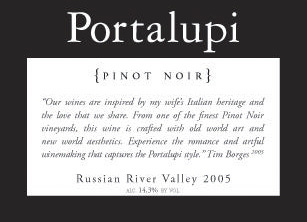 2005 Portalupi Wine Company Russian River Valley Pinot Noir 14.3% alc., 672 cases, $38. This is packaged in one heavy bottle— be careful trying to pour a glass with one hand. The wine, however, is not as heavy handed. · Light- to mediumbodied (more Volnay than Gevrey-Chambertain), the red and blue fruits and loamy highlights lead to a cherry kiss on a long finish. What is most striking here is the creamy texture which is Pinot Noir at is best. The balance is impeccable. The French would say merci!, I say pour me another generous glass, now.
Portalupi Wine Company website is www.portalupiwine.com. The Pinot Noir (and Zin and Barbera) are still available for sale on the website (discounted by the case). The phone is 707-481-5357. This is a future cult star in the making. La Rochelle Winery La Rochelle Winery has made a serious commitment to producing ultra-premium Pinot Noirs. The winery has launched its Heritage Series— small lot specialty Pinot Noirs which honor the Mirassou family’s rich heritage of six generations of winemaking tradition. La Rochelle Winery is owned in partnership by Steven Mirassou, Mike Ghielmetti of Signature Properties, and Phil Tagami of California Commercial Investments. Steven Mirassou oversees winemaking along with winemaker Tom Stutz, who has been crafting Pinot Noir for over 20 years. Steven acquired the La Rochelle label from family members who decided not to continue in the business after the sale of the Mirassou naming rights to Gallo four years ago. Steven, who is also proprietor and winemaker at Steven Kent Winery, wanted to continue his family’s association with the La Rochelle brand. Said Mirassou, ”I simply had to continue our long history of growing and making Pinot Noir from the Monterey vineyards planted in 1961. At the same time, I wanted to pursue my dream of making the finest Pinot Noir possible, in very small lots, from the best vineyard sites in the west that most truly express their unique terroir.” The first wine in the Heritage Series is the 2005 La Rochelle Classic Clones Arroyo Seco Pinot Noir. Additional releases in the series are planned throughout 2007, including the 2005 La Rochelle Santa Lucia Highlands Pinot Noir and 2005 Garys’ Vineyard Santa Lucia Highlands Pinot Noir.
2004 La Rochelle Garys’ Vineyard Santa Lucia Highlands Pinot Noir 15% alc. · There is a nice mélange of red berries and mushrooms on the nose with a solid core of plush red fruits and a kiss of oak and toast in the background. Remarkably balanced considering the high alcohol. In my family, this was controversial, as my wife noticed the alcohol right away on the finish, but I could not detect any heat on the backend. This wine will appeal to those who cherish fruit-driven, big-boy Pinot Noirs.
2005 La Rochelle Classic Clones Arroyo Seco Pinot Noir 14.7% alc., 235 cases, $42. This is the first wine in the Heritage Series, sourced from the Mission Ranch in Arroyo Seco and Garys’ Vineyard in the Santa Lucia Highlands. It is composed of Pommard, Wädenswil and Mariafeld clones from the Mission Ranch, and the Pisoni clone from Garys’ Vineyard. Aged 10 months in French oak. · The nose trumps the flavors at this stage in the wine’s evolution. I wanted to drink the aromas of cherry vanilla cola. Light in weight, the flavors of red fruits, herbs and oak travel smoothly over the palate. The fruit is very shy at this point. I would cellar this wine for a year.
La Rochelle Winery has a tasting room at 5443 Tesla Road in Livermore, CA which is open from 12:00 to 4:30 daily. The wines may be purchased from the website at www.lrwine.com. The phone is 925-243-6442. Andrew Lane Wines Andrew Lane Wines is a small, family-owned winery, named after the owner and winemaker David Dickson’s two sons (Andrew and Lane). The winery has released a Gamay Noir from one of the few remaining Gamay vineyards in Napa Valley (over 50 years old). The grapes for this Gamay Noir are gamay noir a’ just blanc (true Gamay planted in Beaujolais, France).
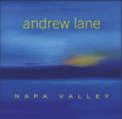 2004 Andrew Lane Gamay Noir Napa Valley 12.9% alc., $19. This wine was aged in neutral oak barrels. · Humus and red cherries perfume the wine which has dark red grape flavors more akin to Merlot than Pinot Noir. Fine tannins and ample acidity spark the finish. Slightly chilled, this wine would be a good companion to barbecue.
Andrew Lane Wines are available for purchase on the website at www.andrewlanewines.com. There is also some retail distribution.
Santa Lucia Highlands Winegrowers EventThe winegrowers and wineries of the Santa Lucia Highlands formed an alliance in 2005, The Wine Artisans of the Santa Lucia Highlands. The association consists of vineyards and wineries that grow grapes here or use this region’s fruit to craft their wines. The goal of the organization is to promote this unique viticultural region and increase awareness and appreciation of the wines of the Santa Lucia Highlands. The Santa Lucia Highlands appellation encompasses more than 4,000 acres of prime vineyards, planted on the southeast-facing terraces of the Santa Lucia mountain range, overlooking the Salinas River Valley. The area’s unique character was recognized with an official AVA status in 1991. 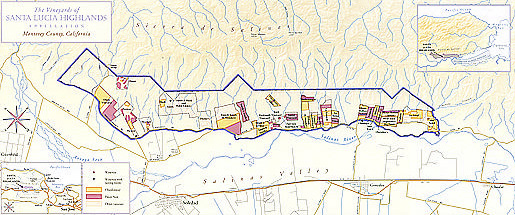
Sonoma GrapemastersLast issue I profiled Kings Hill Cellars as one of a number of wineries allowing budding winemakers to make a small quantity of their own wine. Another player is Sonoma Grapemasters, a new division of Owl Ridge Wine Services in Sebastopol. This custom-crush facility, which has 34 boutique winery clients, offers vine-to-bottle programs that allow non-commercial clients to produce a barrel or more of their own fine wine. The program is a hands-on experience guided by a consulting veteran winemaker. Individuals or groups may take advantage of this ”make-wine-with-the-pros” program. To learn more, contact the Program Director, Stephen Yafa, a well-known wine writer who recently started his own Pinot Noir label, Segue, at Owl Ridge Wine Services. His phone is 415-389-1183 or e-mail him at syafa@sonomagrapemasters.com. Visit the website at www.sonomagrapemasters.com. You know you are itching to make your own wine. Now is your opportunity to explore your “purple thumb.”
Wine Bottle Cellar Labeling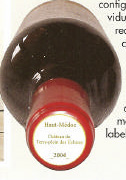 I thought that one could buy circular printable labels by the sheet and print out all of the essential information on the label (wine name, year, price etc.). 1” labels fit the top of the capsule perfectly and are available from www.cellar-label.com. Of course, if your wines are two deep or three deep, you will still need to pull out the closest bottle, but you can then easily observe the bottle(s) behind. If your wines are stored with the neck inward, the 1” labels will not be of use because of the punt on the bottom of most bottles of Pinot Noir. You could acquire larger labels to match the bottom diameter of the bottle.
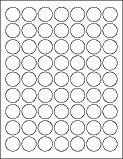 This is a simple idea that never really occurred to me previously. Many of you probably already employ the same or similar method to identify your cellared bottles.
The PinotFileThere is currently a sea of Pinot Noir out there. What is a pinotphile to do? Fortunately, the Prince of Pinot has an unwavering and diligent devotion to Pinot Noir. He searches out, tastes, and reports on the good stuff in his weekly online newsletter, The PinotFile. The inside scoop is preached with just the information you want to know— who is making the juice, how does it taste, and how do you get your hands on it. He finds the small and larger producers that offer the ultimate in Pinot Noir satiation. No scores, no pretentiousness, and no unwarranted criticism. Trust your own palate first, but let the Prince fine tune it. Drink right, join the Crew. |